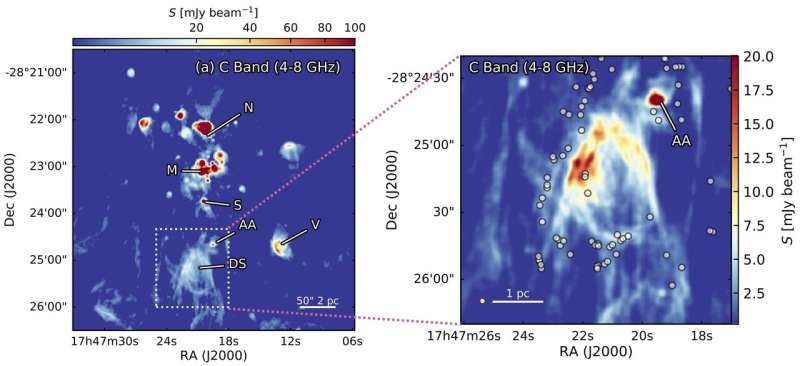Non-thermal emission from cosmic rays accelerated in HII regions

Radio observations at metre-centimetre wavelengths shed light on the nature of the emission of HII regions. Usually, this category of objects is dominated by thermal radiation produced by ionised hydrogen, namely protons and electrons. A number of observational studies have revealed the existence of HII regions with a mixture of thermal and non-thermal radiation. The latter represents a clue to the presence of relativistic electrons. However, neither the interstellar cosmic-ray electron flux nor the flux of secondary electrons produced by primary cosmic rays through ionisation processes are high enough to explain the observed flux densities.
A group of researchers led by Marco Padovani of the Osservatorio Astrofisico di Arcetri showed that it is possible to accelerate local thermal electrons up to relativistic energies in HII region shocks through the first-order Fermi acceleration mechanism. In Padovani et al. (2019), recently published in Astronomy & Astrophysics, they found that the locally accelerated electron flux can explain the observed flux densities.
In particular, they applied their model to the 'deep south' (DS) region of Sagittarius B2, observed with the VLA radio telescope (see Fig. 1), whose results are described in the companion observational paper by Meng et al. (2019). The model succeeded in reproducing the observed flux densities with an accuracy of 20% as well as the spectral indexes (see Fig. 2), also constraining the magnetic field strength (0.3-4 mG), the flow velocity in the shock reference frame (33-50 km s-1), and the density (1-9 104 cm-3) expected in DS (see Fig. 3).

Padovani et al. (2019) also developed an interactive publicly-available on-line tool that computes the shock-accelerated electron flux, the flux density, and the spectral index expected in a HII region in the parameter space density-magnetic field strength for a given set of temperature, flow velocity in the shock reference frame, and observing frequency.
Higher sensitivity, larger field of view, higher survey speed, and polarization capability of future telescopes such as SKA will allow to discover a larger number of HII regions associated with non-thermal emission, giving the opportunity to better characterize the origin of Galactic synchrotron sources.

More information: M. Padovani, et al. Non-thermal emission from cosmic rays accelerated in HII regions. arXiv:1908.07246v2 [astro-ph.HE]: arxiv.org/abs/1908.07246
Journal information: Astronomy & Astrophysics
Provided by INAF



















